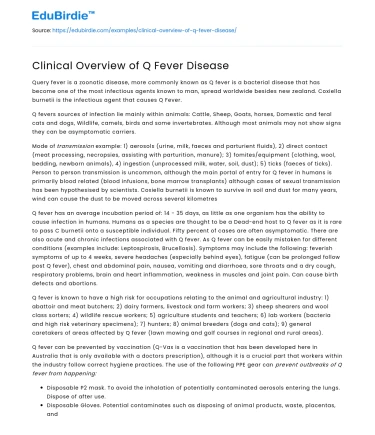Query fever is a zoonotic disease, more commonly known as Q fever is a bacterial disease that has become one of the most infectious agents known to man, spread worldwide besides new zealand. Coxiella burnetii is the infectious agent that causes Q Fever.
Q fevers sources of infection lie mainly within animals: Cattle, Sheep, Goats, horses, Domestic and feral cats and dogs, Wildlife, camels, birds and some invertebrates. Although most animals may not show signs they can be asymptomatic carriers.
Save your time!
We can take care of your essay
- Proper editing and formatting
- Free revision, title page, and bibliography
- Flexible prices and money-back guarantee
Mode of transmission example: 1) aerosols (urine, milk, faeces and parturient fluids), 2) direct contact (meat processing, necropsies, assisting with parturition, manure); 3) fomites/equipment (clothing, wool, bedding, newborn animals), 4) ingestion (unprocessed milk, water, soil, dust); 5) ticks (faeces of ticks). Person to person transmission is uncommon, although the main portal of entry for Q fever in humans is primarily blood related (blood infusions, bone marrow transplants) although cases of sexual transmission has been hypothesised by scientists. Coxiella burnetii is known to survive in soil and dust for many years, wind can cause the dust to be moved across several kilometres
Q fever has an average incubation period of: 14 - 35 days, as little as one organism has the ability to cause infection in humans. Humans as a species are thought to be a Dead-end host to Q fever as it is rare to pass C burnetii onto a susceptible individual. Fifty percent of cases are often asymptomatic. There are also acute and chronic infections associated with Q fever. As Q fever can be easily mistaken for different conditions (examples include: Leptospirosis, Brucellosis). Symptoms may include the following: feverish symptoms of up to 4 weeks, severe headaches (especially behind eyes), fatigue (can be prolonged follow post Q fever), chest and abdominal pain, nausea, vomiting and diarrhoea, sore throats and a dry cough, respiratory problems, brain and heart inflammation, weakness in muscles and joint pain. Can cause birth defects and abortions.
Q fever is known to have a high risk for occupations relating to the animal and agricultural industry: 1) abattoir and meat butchers; 2) dairy farmers, livestock and farm workers; 3) sheep shearers and wool class sorters; 4) wildlife rescue workers; 5) agriculture students and teachers; 6) lab workers (bacteria and high risk veterinary specimens); 7) hunters; 8) animal breeders (dogs and cats); 9) general caretakers of areas affected by Q fever (lawn mowing and golf courses in regional and rural areas).
Q fever can be prevented by vaccination (Q-Vax is a vaccination that has been developed here in Australia that is only available with a doctors prescription), although it is a crucial part that workers within the industry follow correct hygiene practices. The use of the following PPE gear can prevent outbreaks of Q fever from happening:
- Disposable P2 mask. To avoid the inhalation of potentially contaminated aerosols entering the lungs. Dispose of after use.
- Disposable Gloves. Potential contaminates such as disposing of animal products, waste, placentas, and aborted foetuses. Disposable after use.
Proper hygiene practices are crucial to avoid Q fever spreading elsewhere. Where possible disinfect equipment and surfaces with a cleaning agent to kill the C. burnetii bacteria that can be from urine, faeces, blood or other bodily fluids from animals. Outdoor wash areas are provided in some workplaces so that high risk activities are able to control the amount of exposure Q fever gets, it is advised that all dirty clothing, work boots and other clothes that may be worn can be thoroughly washed, this avoids the instance of which that people who are not vaccinated for Q fever are less likely to aquire the disease as the clothing should be left at the workplace or bagged securely and washed separately by someone wo is immune to Q fever.
Diagnosis of Q fever can be challenging to diagnose with the flu like symptoms it can hide as many different diseases and be mistreated for them too. When going to the doctor you should explain that you belong to one of the high risk areas Q fever exists within and understand that the possibility of contracting the disease in the previous 6 weeks. Blood tests will be required and may be repeated after two to three weeks of the symptoms to ensure a reading is not a false negative or positive.
Early treatment of Q fever with the antibiotic doxycycline for the acute sufferers. Chronic sufferers can endure, other prolonged symptoms which may include: vascular infections, endocarditis, hepatitis and osteomyelitis (usually in children). Chronic Q fever, causes treatment dilemmas and may require an infectious disease specialist to intervene.
Q fever in Australia has a well-managed program to stop Q fever from causing major illnesses in workers and individuals. The outlook is good for those infected acutely and can be treated accordingly to ensure a fast recovery. 852 cases of Q fever were notified between January 2006 and December 2007 only 360 of them required hospitalisation in July 2005 and June 2007.






 Stuck on your essay?
Stuck on your essay?

